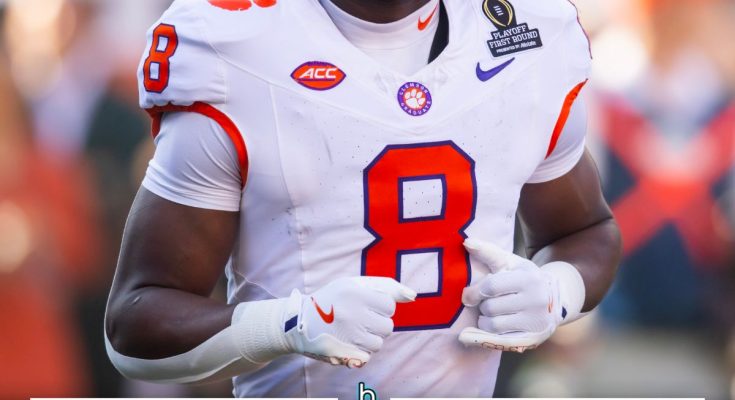Former Wide Receiver Adam Randall Poised to Start at Running Back for Clemson Tigers Despite Limited Experience at New Position
Adam Randall’s path to becoming the likely starting running back for the Clemson Tigers in the 2025 college football season is anything but conventional. A former wide receiver who only transitioned to the backfield in December, Randall’s rapid ascent to the top of the depth chart at a new position is a testament to his raw athleticism, work ethic, and the trust Clemson’s coaching staff has placed in him. But it’s also a move steeped in uncertainty, as the junior enters the season with minimal experience carrying the ball at the collegiate level and even less experience being the focal point of the ground game.
Clemson’s offense, which is undergoing significant restructuring following an inconsistent 2024 campaign, is leaning heavily on Randall’s potential. That potential has always been obvious—Randall was a four-star recruit out of Myrtle Beach, South Carolina, known for his blend of size, speed, and vertical ability. At 6-foot-2 and 215 pounds, he entered the program as a prototypical wide receiver, expected to develop into a primary target in Clemson’s passing game. In flashes, he delivered. During his first two seasons, Randall posted modest receiving numbers, often overshadowed by more established pass-catchers, but coaches routinely praised his explosiveness and toughness.
The decision to move him to running back stemmed from necessity as much as it did from vision. Clemson’s running back depth chart thinned rapidly following the departures of Will Shipley to the NFL and Phil Mafah to the transfer portal. Injuries to backups during bowl season and in spring practices exacerbated the issue, leaving the Tigers perilously thin at a position that’s vital to their offensive identity. Rather than chase unproven talent in the portal or rush incoming freshmen into starting roles, head coach Dabo Swinney and offensive coordinator Garrett Riley took a bold internal gamble. They approached Randall with the idea of switching positions—permanently.
By all accounts, Randall embraced the challenge immediately. In interviews, he has described the transition as both “humbling and energizing.” It’s a sentiment that underscores just how drastically his role has changed. Gone are the downfield routes and jump-ball opportunities. In their place are reads between the tackles, blitz pickups, and the grind of carrying the ball 15 to 20 times per game. It’s a physically demanding job that requires not only agility and speed but also a high level of vision, patience, and toughness. The learning curve is steep, and Randall knows it.
What he may lack in experience, though, he makes up for in athletic gifts. His time in the Clemson strength and conditioning program has built a solid foundation of power and balance, essential traits for any ball carrier. His background as a receiver gives him an edge in the passing game as well—something Riley’s offense is likely to leverage heavily with swing passes, screens, and wheel routes designed to get him in space. Randall’s size and open-field speed could make him a dangerous dual threat, even if he’s still learning the nuances of running between the tackles.
The coaching staff’s confidence in him seems unshaken, even as skeptics raise fair questions about his readiness. Position coach C.J. Spiller, himself a Clemson legend at running back, has been instrumental in bringing Randall up to speed. Spiller has praised Randall’s football IQ and willingness to absorb information. According to insiders close to the program, Randall has spent countless hours in film study, not only dissecting the Tigers’ playbook but also watching tape of elite running backs to learn technique, vision, and footwork. He’s gone through intensive drills focusing on pad level, lateral quickness, and ball security—all areas that can’t be fully mastered in just a few months, but where measurable progress is being made.
Spring practices were the first real glimpse fans got of Randall’s potential in his new role. While he didn’t dominate scrimmages, he showed flashes of brilliance—a sharp cut to evade a linebacker here, a tough finish through contact there. His most notable moment came during the team’s spring game, where he broke off a 40-yard run that showcased his acceleration and field vision. Coaches emphasized that while Randall is still raw, he’s learning quickly and progressing daily. His teammates, too, have taken notice, with several linemen and quarterbacks publicly expressing their excitement at seeing what he can do with a full workload.
That excitement, though, is tempered with the knowledge that the position demands more than just highlight-reel plays. Randall will be tasked with protecting the quarterback on passing downs—a skill that requires both technique and instinct. He’ll have to diagnose defensive fronts, anticipate blitzes, and maintain ball security in high-pressure situations. These are not easily acquired skills, especially in the ACC, where defenses are fast, complex, and punishing. Mistakes will come, and growing pains are to be expected.
Still, the upside is tantalizing. Clemson is hoping that Randall can replicate some of the success seen by other wide receivers who have transitioned to running back, a path that’s rare but not unprecedented. Players like Ty Montgomery and Antonio Gibson made similar shifts in college or early in their NFL careers and found success by blending speed, elusiveness, and receiving skills into versatile backfield roles. Clemson’s coaching staff appears to be betting that Randall can follow a similar trajectory—albeit under very different circumstances.
Much will depend on how the offensive line gels this season, as well as how quickly Randall can adapt to the mental and physical rigors of his new position. Clemson’s schedule doesn’t afford much time for gradual development. Their early-season slate includes matchups with Georgia Tech, Notre Dame, and NC State—all teams with aggressive, disciplined defensive fronts. Randall will be tested early and often, and his performance could very well dictate the trajectory of Clemson’s season. If he excels, he could provide the spark the Tigers need to return to national contention. If he struggles, the offense may sputter and force the team to reevaluate its strategy on the fly.
There’s also the broader question of how this move impacts Randall’s future beyond college. As a receiver, he was considered a fringe NFL prospect with intriguing tools. As a running back, his draft profile is harder to project. Running backs typically face shorter careers and steeper attrition rates, but Randall’s unique skill set might make him appealing to teams looking for hybrid weapons. For now, however, both he and Clemson are focused solely on the present. Randall has said repeatedly that his only goal is to help the team win, no matter where he plays. That attitude, combined with his physical tools, is part of what makes this experiment so compelling.
Ultimately, Adam Randall’s story is one of adaptation, opportunity, and belief. Clemson is taking a calculated risk in handing the keys of its backfield to a player with limited experience and a wide receiver’s résumé. But in the world of college football, where rosters shift constantly and needs arise unpredictably, innovation often comes from unlikely places. Randall may not be the conventional choice at running back, but he could be the right one. His journey will be watched closely by fans, analysts, and opponents alike—not just for what it says about him, but for what it says about Clemson’s ability to evolve, take risks, and find new ways to win.
If Randall can deliver on even a fraction of the promise his coaches see in him, the Tigers could have a breakout star on their hands—and a new blueprint for unlocking talent in unexpected ways.



